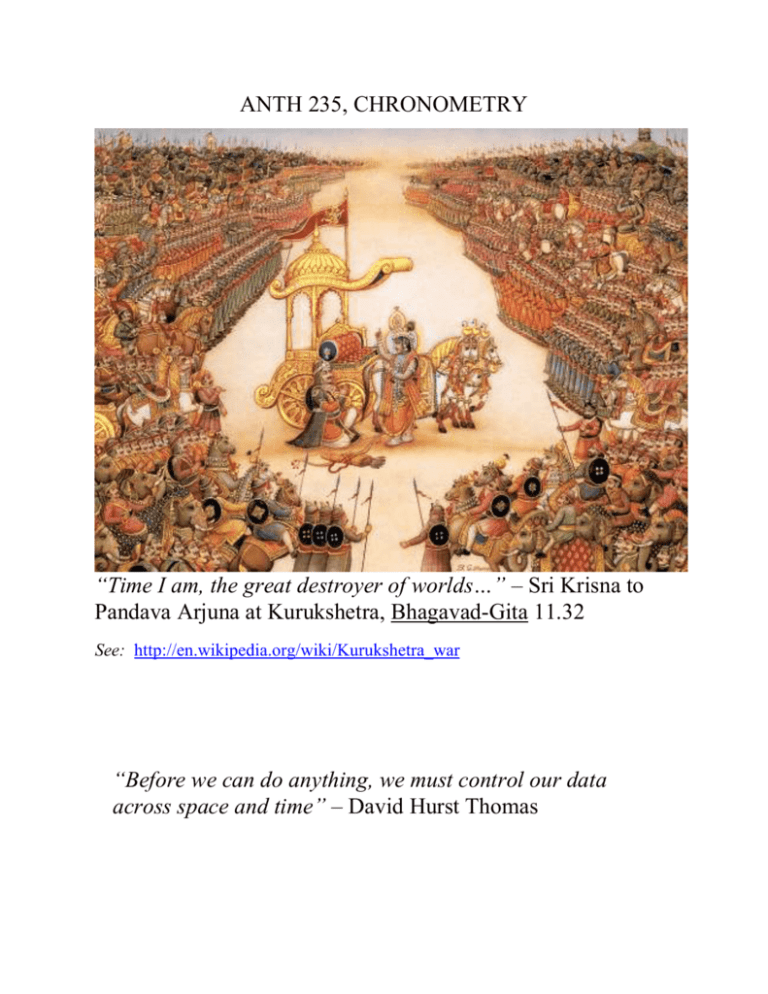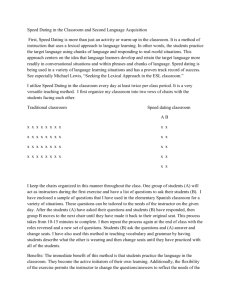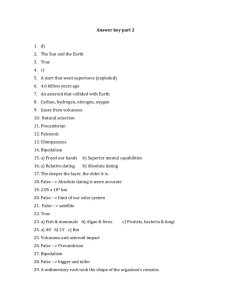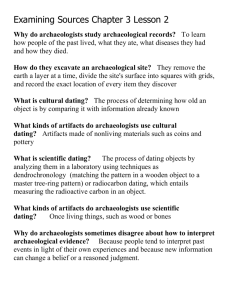Link to Document
advertisement

ANTH 235, CHRONOMETRY “Time I am, the great destroyer of worlds…” – Sri Krisna to Pandava Arjuna at Kurukshetra, Bhagavad-Gita 11.32 See: http://en.wikipedia.org/wiki/Kurukshetra_war “Before we can do anything, we must control our data across space and time” – David Hurst Thomas To simply describe the sequence of past events, all we really need to know is the age relationship of different objects. (That is, X is older than Y; Y is older than Z, etc.) But, to address processual questions, which try to explain change, it is necessary to know more. relative time: In relative time, we only know if something is younger or older than something else, but we do not know how much older or younger. “absolute” time: In “absolute” or chronometric time, we speak in terms of the ages of objects or events. “Absolute” dates are thus always accompanied by a unit designator, such as years Anno Domini (AD), Before Christ (BC), Before the Common Era (BCE), Before Present (BP), etc. ESSENTIAL CHRONOMETRIC ABBREVIATIONS: BP = Before Present (by convention AD 1950) BCE = Before the Common Era, preferred over BC (Before Christ) or ACN (ante Christum natum) CE = Common Era; preferred over AD (Anno Domini, “In the year of the Lord,” itself a contraction of Anno Domini Nostri Jesu Christi, “in the year of our Lord Jesus Christ”) KYBP = Kilo Years Before Present (also KA, Kiloyears Ago and KYA or KYR, Kilo Years Ago) MYA = Mega (or Millions of) Years Ago (also MA, Megayears Ago; MYBP and MYR, Megayears Before Present) ADDITIONAL EXPLANATORY NOTES: BP, BC, BCE, and CE are always written after the date (e.g., 2500 BCE). AD is always written before the date (e.g., AD 2004). RCYBP refers to “radiocarbon years before present.” Since radiocarbon years calendar years, a calibration curve is used to establish the relationship between the two scales. Some authors consider some of these abbreviations case sensitive (e.g., “bp” indicates an uncalibrated date while “BP” represents a calibrated date). Archaeological dates are often reported in the Islamic world as BH (Before the Hejira) or AH (After the Hejira), referencing the Prophet Muhammad’s departure from Mecca in September, 622 CE. RELATIVE DATING TECHNIQUES: stratigraphy: an interpretive science Is it possible to determine which ceramic vessel is later: 4, 5, or 6? If so, which one? Is it possible to determine which vessel is earlier: 1, 2, 6, or 7? If so, which one? In what order were the burials interred, from oldest to youngest? Which is older, burial Y or vessel 3? Was the wall built before or after burial Y was interred? seriation (two types): based on observable changes in artifacts through time stylistic seriation frequency seriation Stylistic seriation is based on a technique called sequence dating developed first by Sir Flinders Petrie through his excavations of Pre-Dynastic clay pots at Diospolis Parva, Upper Egypt in 1898-1899. See: http://www.digitalegypt.ucl.ac.uk/pottery/seqdates.html Flinders Petrie’s sequence dating of Pre-Dynastic clay vessels from Diospolis Parva, Upper Egypt The arrangement of artifact types in a sequence is based on two simple ideas: first, products of a given period and place have a distinctive style or design; and second, that changes in style are gradual, or “evolutionary.” Gradual changes in design are evident in this history of the automobile (top row)* and of the prehistoric European axe (bottom row: 1, stone; 2-5, bronze). However, the rate of change (a century for the automobile; millennia for the axe) has to be deduced from “absolute” or chronometric dating methods, like radiocarbon (14C), etc. *who knew that the pinnacle of automotive technology was a mid-1970s Citroën DS? Death’s Head pattern tombstone from Colonial New England Cherub pattern tombstone from Colonial New England Urn-and-Willow pattern tombstone from Colonial New England James Deetz’s seriation of Colonial New England tombstones Whether tombstones or corporate logos, the principles of seriation are the same. cross-dating: establishing relative or absolute age by comparison to a known sequence “ABSOLUTE” OR CHRONOMETRIC DATING: age range or time depth: at what age ranges is it feasible to use particular dating methods Accuracy is a measure of systematic error and refers to the “closeness” of a chronometric estimate to the true value. Precision is a measure of random error and refers to how often we arrive at the same answer on repeated “tries” or measurements. Resolution is closely related to precision and refers to the shortest interval of time by which two assays can be distinguished. direct vs. indirect dating methods calendrics The Mexica Sun Stone or “Aztec Calendar,” ca. 1450 CE, Mexico (Carved basalt, 3.6 meters in diameter) dendrochronology: tree-ring dating, the most accurate of all chronometric dating techniques Radiometric “absolute” dating techniques: half-life: the length of time necessary for one-half of the radioactive atoms of a particular isotope to decay. radiocarbon or 14C dating: possibly the single most important technological achievement in archaeology, ever. Half-life of 14C is about 5730 years. The technique is useful from about 50,000 years ago to the present. Time is measured in years BP (before present), which is defined as 1950 CE by convention. K/Ar or potassium/argon dating: based on the radioactive decay of potassium to argon. Due to the long half-life of the 40K isotope (1.31 billion years!), this technique is useful for dating really old things (200,000 years), but only in volcanic environments. The “dating gap”: radiocarbon dating can be taken back to about 50,000 years ago reliably, and K/Ar can only be used before about 200,000 years ago. Thermoluminescence (TL), electron spin resonance (ESR), and optically stimulated luminescence (OSL) can partially fill the “dating gap” Collecting samples for thermoluminescence (TL) dating problems of association can be found for any dating technique, even calendrics PRACTICAL CONSIDERATIONS: Relative and absolute dating each have associated costs and benefits: relative dating is free, fast, and reliable, BUT unscaled “absolute” dating is expensive, slow, and less reliable, BUT scaled relative dating can be performed in the field, on the spot. “Absolute” cannot (except calendrics) relative dating generally can only be used regionally “absolute” dating can be applied globally Thus, one approach is not better than the other is. Relative and “absolute” dating are complementary in that they provide independent means of assessing age. Archaeologists serve their interests best by using relative and “absolute” techniques together.








